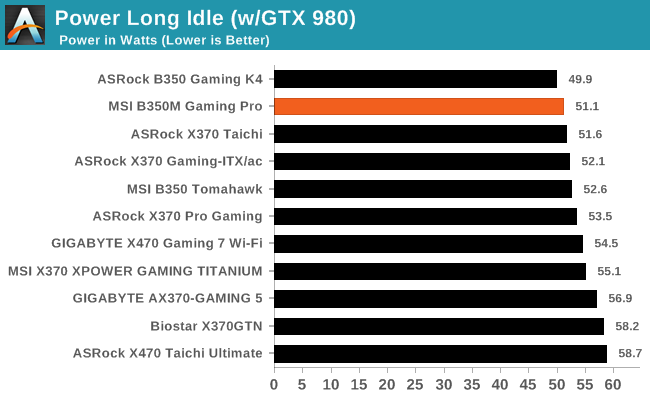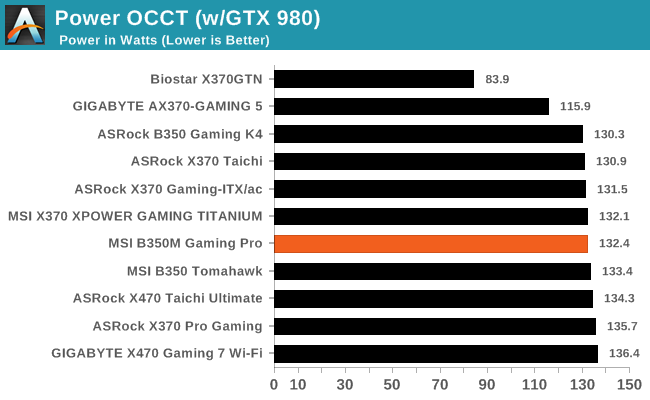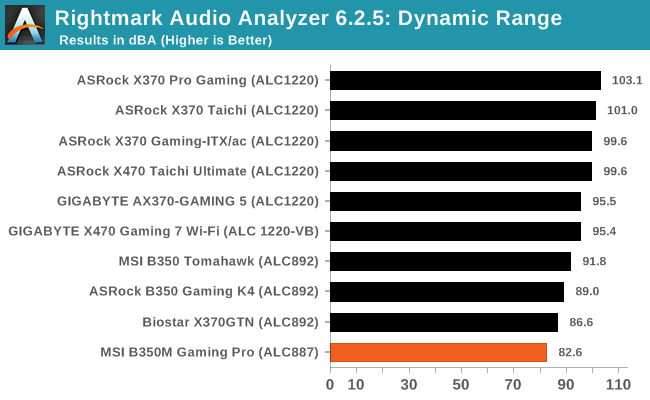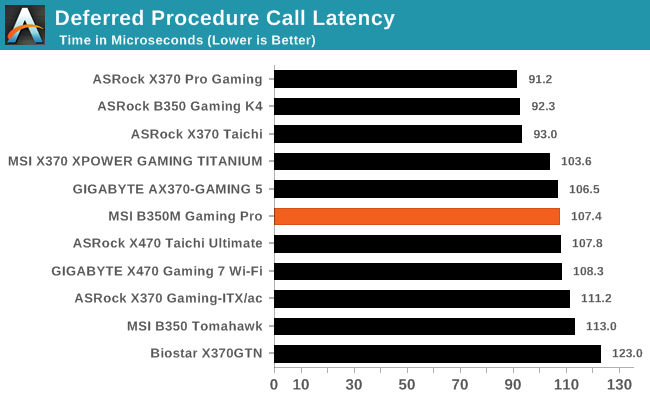The MSI B350M Gaming Pro Review: Micro Size, Micro Price
by Gavin Bonshor on October 12, 2018 10:00 AM EST- Posted in
- Motherboards
- Gaming
- AMD
- MSI
- mATX
- AM4
- B350
- Ryzen
- B350M Gaming Pro
System Performance
Not all motherboards are created equal. On the face of it, they should all perform the same and differ only in the functionality they provide - however, this is not the case. The obvious pointers are power consumption, but also the ability for the manufacturer to optimize USB speed, audio quality (based on audio codec), POST time and latency. This can come down to manufacturing process and prowess, so these are tested.
Power Consumption
Power consumption was tested on the system while in a single ASUS GTX 980 GPU configuration with a wall meter connected to the Thermaltake 1200W power supply. This power supply has ~75% efficiency > 50W, and 90%+ efficiency at 250W, suitable for both idle and multi-GPU loading. This method of power reading allows us to compare the power management of the UEFI and the board to supply components with power under load, and includes typical PSU losses due to efficiency. These are the real world values that consumers may expect from a typical system (minus the monitor) using this motherboard.
While this method for power measurement may not be ideal, and you feel these numbers are not representative due to the high wattage power supply being used (we use the same PSU to remain consistent over a series of reviews, and the fact that some boards on our test bed get tested with three or four high powered GPUs), the important point to take away is the relationship between the numbers. These boards are all under the same conditions, and thus the differences between them should be easy to spot.



While the B350M Gaming Pro has good power consumption readings in our idle and long idle tests, it managed to draw more power under load than MSI's own flagship X370 XPOWER Gaming Titanium ATX board.
Non-UEFI POST Time
Different motherboards have different POST sequences before an operating system is initialized. A lot of this is dependent on the board itself, and POST boot time is determined by the controllers on board (and the sequence of how those extras are organized). As part of our testing, we look at the POST Boot Time using a stopwatch. This is the time from pressing the ON button on the computer to when Windows starts loading. (We discount Windows loading as it is highly variable given Windows specific features.)

The B350M Gaming Pro POST'ed some respectable times with the only boards going better costing more than double the price. There wasn't much difference between the default and stripped versions which signal a consistent and optimized boot order; users may find the boot times are even faster with Windows 10 WHQL support enabled in the BIOS.
Rightmark Audio Analyzer 6.2.5
Rightmark:AA indicates how well the sound system is built and isolated from electrical interference (either internally or externally). For this test we connect the Line Out to the Line In using a short six inch 3.5mm to 3.5mm high-quality jack, turn the OS speaker volume to 100%, and run the Rightmark default test suite at 192 kHz, 24-bit. The OS is tuned to 192 kHz/24-bit input and output, and the Line-In volume is adjusted until we have the best RMAA value in the mini-pretest. We look specifically at the Dynamic Range of the audio codec used on the rear panel of the board.

The B350M Gaming Pro displayed the worst Dynamic Range performance so far from an AM4 motherboard, which is to be expected given the board is the lowest priced out of all the ones on test. The Realtek ALC887 is the slightly lower spec sibling of the Realtek ALC892 and it clearly shows in our testing.
DPC Latency
Deferred Procedure Call latency is a way in which Windows handles interrupt servicing. In order to wait for a processor to acknowledge the request, the system will queue all interrupt requests by priority. Critical interrupts will be handled as soon as possible, whereas lesser priority requests such as audio will be further down the line. If the audio device requires data, it will have to wait until the request is processed before the buffer is filled.
If the device drivers of higher priority components in a system are poorly implemented, this can cause delays in request scheduling and process time. This can lead to an empty audio buffer and characteristic audible pauses, pops and clicks. The DPC latency checker measures how much time is taken processing DPCs from driver invocation. The lower the value will result in better audio transfer at smaller buffer sizes. Results are measured in microseconds.

While none of the AM4 motherboards tested so far have been optimized for DPC Latency, the B350M Gaming Pro puts in a decent showing with a middle of the road scoring between the premium X370 XPOWER Gaming Titanium and the more comparable ATX offering, the B350 Tomahawk.










18 Comments
View All Comments
Lazlo Panaflex - Friday, October 12, 2018 - link
LOLHey Gavin, how about grabbing an MSI 450M Gaming Plus and doing a comparison?
PeachNCream - Friday, October 12, 2018 - link
Monitors live much longer useful lives than the computers connected to them.Lucky Stripes 99 - Sunday, October 14, 2018 - link
People in this price category are more likely to have older gear. As example, I'm still using DVI because that's what my KVM accepts. The newer DisplayPort version of my KVM costs $370. Until I upgrade to a 4K monitor, there isn't much point in making the switch.Eletriarnation - Monday, October 15, 2018 - link
Seems like it would be ideal if they could replace DVI-D with DVI-I and add DP to allow 4K @ 60Hz, but maybe this wasn't designed with Raven Ridge in mind.ballsystemlord - Friday, October 12, 2018 - link
I seems as though every AMD motherboard you review has 6+2 or less phases, whereas the filled in sections of your Intel Z390 MB list indicates 8+2 and often 10+2 or 12+2 or more phases. Why is this?Do AMD processors really require less power? Or are the MB manufacturers unfairly cheapening the AMD MBs on purpose?
notashill - Saturday, October 13, 2018 - link
Z390 is the high end Intel chipset, of course the boards for it are high end. These B350/B450 boards should be compared to B360 boards, and they are not so different. X370/X470 mobos are what you want to compare with Z390 and they usually have plenty of power phases. The last one reviewed on Anandtech had 16.ballsystemlord - Sunday, October 14, 2018 - link
Ah, yes. I'm just not up on which Intel chipset is which "end". Thanks!AlB80 - Saturday, October 13, 2018 - link
3 phase of fossil mosfets. Don't touch this.